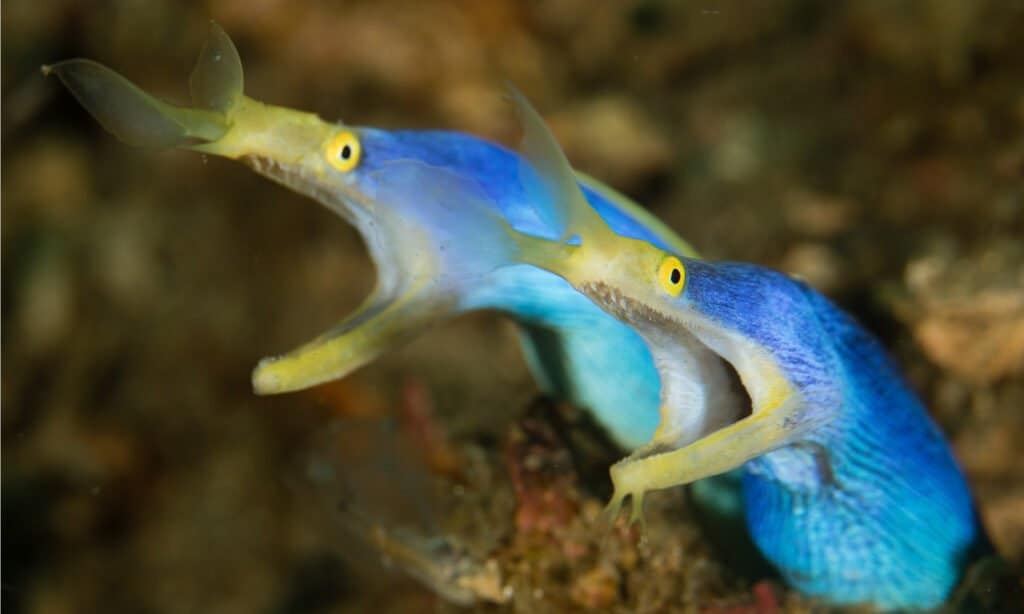Ribbon Eel
Rhinomuraena quaesita
Can fit its body into a tiny crevice of a reef
Advertisement
Ribbon Eel Scientific Classification
- Kingdom
- Animalia
- Phylum
- Chordata
- Class
- Actinopterygii
- Order
- Anguilliformes
- Family
- Muraenidae
- Genus
- Rhinomuraena
- Scientific Name
- Rhinomuraena quaesita
Read our Complete Guide to Classification of Animals.
Ribbon Eel Conservation Status
Ribbon Eel Facts
- Prey
- Crustaceans, small fish
- Group Behavior
- Solitary
- Fun Fact
- Can fit its body into a tiny crevice of a reef
- Estimated Population Size
- unknown
- Biggest Threat
- Caught as exotic pets
- Most Distinctive Feature
- Brightly colored body
- Other Name(s)
- Ribbon moray, Leaf-nosed moray, Bernis eel
- Gestation Period
- unknown
- Optimum pH Level
- 8.1-8.4
- Habitat
- coral reefs
- Predators
- Large fish, sea birds
- Diet
- Carnivore
- Type
- Anguilliformes
- Common Name
- Eel
- Number Of Species
- 223
View all of the Ribbon Eel images!
The ribbon eel is one of 223 species of moray eel.
The ribbon eel is also called a ribbon moray, a Bernis eel and a leaf-nosed moray. These eels live on coral reefs in the Pacific and Indian Oceans off the coasts of southern Japan, eastern Africa, French Polynesia and Australia. They can live for 20 years in the wild, but don’t survive for very long in captivity.
4 Ribbon Eel Facts
- Both male and female: All ribbon eels are born male. But, as this animal ages and changes colors, it develops female reproductive parts allowing it to lay eggs.
- Ghost eels: The white or ghost ribbon eel is closely related to the blue-ribbon eel. It’s called a ghost because of its shining white skin. Also, ghost eels only come out at night to hunt. They live in the same habitat as blue-ribbon eels.
- Transparent bodies: During the larva stage, a ribbon eel’s body is transparent or see-through.
- Mouth breathing eels: A ribbon eel is usually seen with its mouth opening and closing. This is not a sign of aggression. An eel does this to push water over its gills to breathe.
Ribbon Eel Classification and Scientific Name
This eel’s scientific name is Rhinomuraena quaesita. The Greek word Rhinomuraena translates to moray eel nose which refers to this eel’s distinctive elongated nose. The word quaesita means sought after referring to the fact that this eel stays hidden in coral reefs.
Other names for this eel include ribbon moray, Bernis eel and the leaf-nosed moray. It is in the Muraenidae family and the class Actinopterygii.
The moray eel family (Muraenidae) has 223 members! Some examples:
- Anarchias seychellensis
- Enchelycore schismatorhynchus
- Scuticaria tigrina
- Gymnothorax kidako
Types of Moray Eel: The Different Species
This eel belongs to the moray eel family. This family has 223 members of different sizes and colors. Many of them live in coral reefs in the Pacific and Indian Oceans.
Some species in the moray eel or Muraenidae family include:
- Seychelles moray: This moray eel lives in coral reefs off the western and eastern coasts of Australia. It has a yellow tipped tail.
- White-margined moray: It lives near Christmas Island in the Indian Ocean. Its habitat includes coral reefs, and it hunts in lagoons. It’s named for the white line on its dorsal fin and measures 47 inches.
- Tiger moray: This moray gets its name from the black or dark brown splotchy pattern atop its light brown body. They live near the bottom of coral reefs located in the Gulf of California and elsewhere in the Indian and Pacific Oceans.
- Kidako moray: Measuring two to three feet long this moray is notable for its brown body featuring a white snowflake pattern.
Ribbon Eel Appearance
This eel has been compared to the mythical Chinese dragon due to its long curving body and dorsal fin. It changes color as it gets older. A larva eel is transparent while a juvenile is black with a dorsal fin of yellow. As it becomes fully grown, it turns a brilliant blue with a yellow dorsal fin.
These eels are all born male but develop female reproductive organs later in life. At this point, it’s able to lay eggs. These eels can grow to 51 inches in size.
The movements of this eel are similar to a thin ribbon waving through the air. A flowing, zig-zagging movement through the water. It’s easy for these eels to disappear into a tiny crevice in a coral reef due to their narrow body. Their speed combined with the ability to wiggle inside a coral reef can help these eels escape predators.

A pair of blue ribbon eels found in Lembeh Strait, Indonesia.
©SergeUWPhoto/Shutterstock.com
Ribbon Eel Distribution, Population, and Habitat
This eel’s range includes the eastern coast of Africa, the northern to the southern coasts of Japan, French Polynesia and the northern coast of Australia. It lives in coral reefs and can be seen from one to 220 feet down in the saltwater ocean.
The population of this eel is unknown. However, it’s considered Least Concern on the IUCN Red List.
Ribbon Eel Predators and Prey
Ribbon eels are carnivores that don’t need to leave the safety of their coral reef to find food!
What do ribbon eels eat?
They eat small fish and crustaceans. Instead of coming out of its coral reef crevice, they stick its head out. It uses its fluttery nostrils to attract prey. A small fish or crustacean is likely to mistake this fluttery object as something to eat. When the prey gets too close, the eel grabs it.
What eats ribbon eels?
Fish that are larger in size and sea birds eat ribbon eels.
Though they are sometimes captured and sold at a high price as exotic pets, these eels are considered Least Concern.
Reproduction and Lifespan
Scientists believe the breeding season is sometime between late winter and early spring. A female lays eggs and a male releases sperm to fertilize them. They lay an average of four eggs that hatch in about eight weeks.
Newly hatched eels are called larvae and are transparent. In short, they have the shape of an eel, but you can see through them.
Soon, a ribbon eel progresses into the juvenile stage. At this point, its body is black with a yellow dorsal fin. At the adult stage, the eel becomes bright blue with a yellow dorsal fin.
In the wild, these eels can live up to 20 years. Unfortunately, they pay a sad price when captured to keep as pets. They usually die within a month in a fish tank.
Fishing and Cooking
Ribbon eels are not eaten by humans. Some humans capture them to put into aquariums in private homes or businesses.
View all 114 animals that start with RRibbon Eel FAQs (Frequently Asked Questions)
Where are ribbon eels found?
They are found in the Indian and Pacific Oceans near Australia, eastern Africa, Japan, and French Polynesia.
Is a ribbon eel safe?
Yes. This eel is more likely to swim away than confront a human.
Do ribbon eels bite?
Sometimes. These eels have sharp teeth, so if one felt threatened it could bite.
How big do ribbon eels get?
They can grow up to 51 inches.
Can you have a ribbon eel as a pet?
Though they can be bought for a high price at exotic pet stores, they should not be kept as pets. They become stressed, stop eating and die in a fish tank. Ribbon eels don’t belong in an aquarium or a fish tank. They are best left in their natural coral reef habitat.
Thank you for reading! Have some feedback for us? Contact the AZ Animals editorial team.
Sources
- , Available here: https://twofishdivers.com/blog/ribbon-eel-facts/
- , Available here: https://www.thainationalparks.com/species/ribbon-eel
- , Available here: https://www.iucnredlist.org/species/155301/115297865
- , Available here: https://en.wikipedia.org/wiki/Ribbon_eel
- , Available here: https://biogeodb.stri.si.edu/sftep/en/thefishes/species/316
- , Available here: https://en.wikipedia.org/wiki/Anarchias_seychellensis
- , Available here: https://reeflifesurvey.com/species/gymnothorax-kidako/
- , Available here: https://lifeoffish.com/ribbon-eel-care-must-know-care-facts-behavior-breeding/
- , Available here: https://nhpbs.org/wild/Muraenidae.asp

















